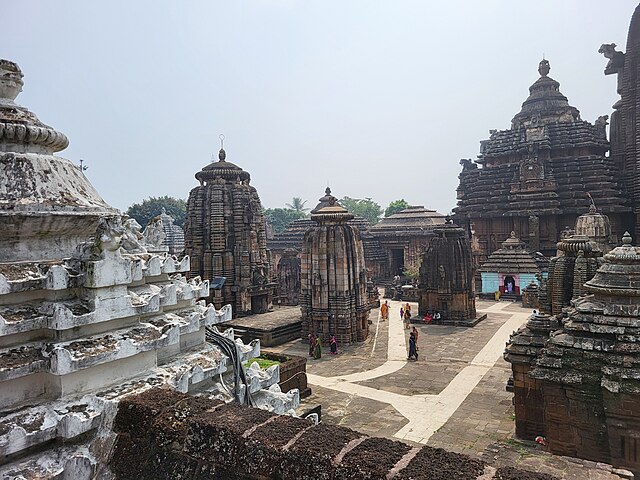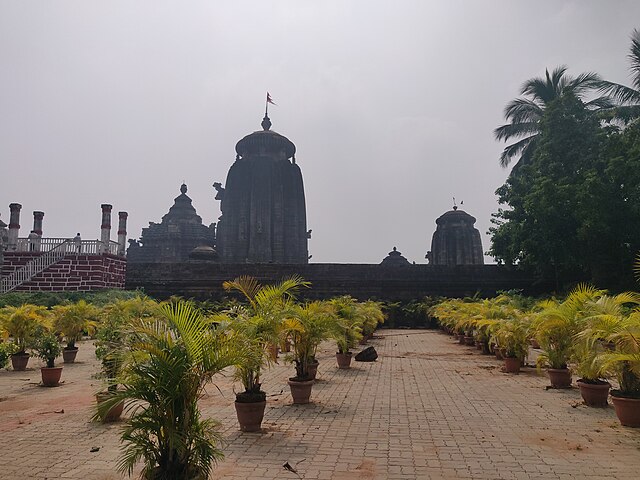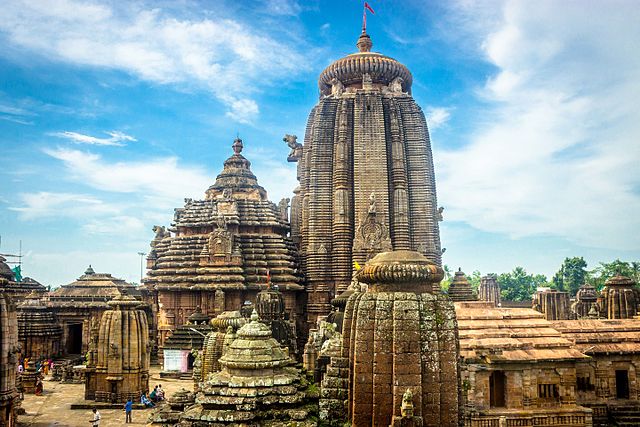Standing majestically in the heart of Bhubaneswar, the Lingaraj Temple represents one of India’s most spectacular examples of ancient temple architecture. This 1000-year-old monument isn’t just a place of worship – it’s a testament to the incredible craftsmanship and devotion of the Kalinga dynasty. Have you ever wondered what makes this temple so special that it draws millions of devotees and tourists from around the world?
The Lingaraj Temple, dedicated to Lord Shiva (known here as Harihara), serves as the crown jewel among Bhubaneswar’s numerous temples. Its towering spire, reaching 180 feet into the sky, dominates the city’s skyline and continues to inspire awe in everyone who beholds it. This architectural masterpiece represents the pinnacle of Kalinga temple architecture and stands as a living symbol of Odisha’s rich cultural heritage.
Historical Background and Origins
The story of Lingaraj Temple begins in the 11th century when King Yayati I of the Somavamsi dynasty laid its foundation. However, like many ancient structures, this temple’s history is layered with multiple phases of construction and renovation spanning several centuries. The temple we see today is the result of continuous patronage from various rulers who understood its significance.
Archaeological evidence suggests that the site held religious importance even before the current structure was built. Ancient texts and inscriptions found in the vicinity indicate that this location was considered sacred for centuries, making it a natural choice for such a grand temple complex.
The Somavamsi Dynasty Legacy
The Somavamsi rulers, particularly King Yayati I, envisioned creating a temple that would surpass all others in grandeur and spiritual significance. They invested enormous resources and employed the finest craftsmen of their time to ensure that every aspect of the temple reflected their devotion and artistic vision.
Under their patronage, the temple became not just a religious center but also a hub of cultural activities, learning, and artistic expression. The dynasty’s commitment to this project established a tradition that subsequent rulers continued, each adding their own contributions to the temple’s magnificence.
Evolution Through the Centuries
Over the centuries, various rulers from different dynasties contributed to the temple’s expansion and beautification. The Ganga dynasty, Eastern Ganga rulers, and later the Maratha rulers all left their mark on this sacred complex. Each addition was carefully planned to harmonize with the existing structure while adding new dimensions to its grandeur.
This evolutionary process resulted in the temple complex we see today – a harmonious blend of architectural styles and periods that somehow manages to maintain its unified aesthetic appeal. The temple’s ability to incorporate changes while preserving its essential character speaks to the remarkable vision of its original architects.
Architectural Marvel of Kalinga Style
The Lingaraj Temple stands as the finest example of Kalinga architecture, a style that emerged in ancient Odisha and influenced temple construction throughout eastern India. This architectural style is characterized by its distinctive features that set it apart from other Indian temple traditions.
The temple’s design follows the traditional Kalinga template, which divides the structure into four main components: the Vimana (main sanctum), Jagamohana (assembly hall), Natamandira (dancing hall), and Bhogamandapa (offering hall). Each section serves a specific purpose while contributing to the overall aesthetic and functional harmony of the complex.
The Magnificent Vimana (Main Tower)

The temple’s main tower, or Vimana, rises to an impressive height of 180 feet and serves as the focal point of the entire complex. This tower isn’t just tall – it’s a masterpiece of engineering that has withstood centuries of natural disasters and human conflicts.
The Vimana’s design incorporates sophisticated structural techniques that distribute weight evenly and provide stability against earthquakes and strong winds. The tower’s surface is adorned with countless sculptures and decorative elements that tell stories from Hindu mythology and showcase the incredible skill of medieval artisans.
What makes this tower particularly remarkable is its perfect proportions. The architects achieved a balance between height and width that creates a sense of upward movement while maintaining structural integrity. The gradual tapering from base to summit creates an optical illusion that makes the tower appear even taller than its actual height.
Intricate Stone Carvings and Sculptures
Every surface of the Lingaraj Temple tells a story through stone. The walls, pillars, and architectural elements are covered with intricate carvings that represent one of the finest achievements in Indian sculptural art. These aren’t just decorative elements – they’re a comprehensive visual narrative of Hindu philosophy and mythology.
The sculptural program includes depictions of various deities, celestial beings, animals, and floral motifs. Each carving demonstrates the artist’s deep understanding of both artistic technique and religious symbolism. The level of detail achieved in these stone sculptures is so fine that many appear almost lifelike.
Decorative Elements and Motifs
The decorative scheme of the temple incorporates traditional Odishan motifs alongside pan-Indian Hindu iconography. You’ll find recurring patterns of lotus flowers, which symbolize purity and spiritual awakening, alongside geometric designs that create visual rhythm and movement.
Animal figures, particularly lions and elephants, appear frequently throughout the temple, serving both decorative and symbolic purposes. These animals represent various divine attributes and serve as guardians of the sacred space. The integration of these elements creates a rich visual tapestry that rewards careful observation.
Religious Significance and Deity
The religious significance of Lingaraj Temple extends far beyond its architectural magnificence. This temple represents a unique aspect of Hindu worship that reflects the syncretic nature of Indian spirituality. The primary deity worshipped here offers insights into the complex theological concepts that developed in medieval India.
The temple serves as one of the most important pilgrimage destinations in eastern India, drawing devotees who come to seek blessings, perform rituals, and experience the divine presence that permeates this sacred space. The religious practices observed here have remained largely unchanged for centuries, providing a direct link to ancient traditions.
Lord Harihara: The Unique Fusion
The presiding deity of Lingaraj Temple is known as Harihara, a unique form that represents the fusion of Lord Shiva and Lord Vishnu. This theological concept demonstrates the sophisticated understanding of divine unity that characterized medieval Indian philosophy. Harihara symbolizes the idea that different aspects of the divine are ultimately one.
This fusion deity is particularly significant because it bridges what might otherwise be seen as sectarian differences between Shaivism and Vaishnavism. Devotees of both traditions find spiritual fulfillment in worshipping Harihara, making the temple a unifying force in the religious landscape of Odisha.
The Harihara form is represented by a massive Shiva Linga made of granite, which measures about 8 feet in diameter. This Linga is considered self-manifested (Swayambhu), adding to its sacred significance. The size and natural origin of this Linga make it one of the most revered Shiva Lingas in India.
Sacred Rituals and Ceremonies
The ritual life of Lingaraj Temple follows ancient Vedic traditions while incorporating local customs that have evolved over centuries. The temple maintains a complex schedule of daily, weekly, and annual ceremonies that ensure continuous worship and maintain the sacred atmosphere.
The temple employs numerous priests who specialize in different aspects of ritual worship. These priests, many of whom come from families that have served the temple for generations, maintain the authenticity of traditional practices while adapting to contemporary needs.
Daily Worship Practices
Each day at Lingaraj Temple begins before dawn with the Mangala Arati, a ceremony that awakens the deity and prepares for the day’s worship. This is followed by a series of ritualistic offerings, prayers, and ceremonies that continue throughout the day until the final evening Arati.
The daily routine includes specific offerings of food, flowers, and other materials that hold symbolic significance. Devotees can participate in these rituals or observe them, gaining spiritual merit through their presence and devotion. The rhythmic chanting, fragrant incense, and ceremonial bells create an atmosphere that transports visitors into a sacred realm.
Temple Complex Layout and Structure
The Lingaraj Temple complex spans a vast area and includes numerous structures that serve different religious and administrative functions. Understanding the layout helps visitors appreciate the careful planning that went into creating this sacred space and makes navigation easier during visits.
The complex is enclosed by massive walls that separate the sacred space from the secular world outside. These walls aren’t just boundaries – they’re integral parts of the temple’s spiritual and architectural design, creating a sense of enclosure and sanctity that enhances the worship experience.
The Four Main Sections
The temple follows the traditional Kalinga architectural plan by dividing into four main sections, each with its specific function and architectural character. The Vimana houses the main deity and represents the most sacred space within the complex.
The Jagamohana serves as the assembly hall where devotees gather for prayers and religious discourse. This spacious hall features beautiful architectural elements and provides a transition space between the outer world and the inner sanctum.
The Natamandira, or dancing hall, reflects the important role that classical dance played in temple worship. This section features intricate carvings depicting various dance poses and musical instruments, celebrating the arts as forms of devotion.
The Bhogamandapa serves as the offering hall where food offerings are prepared and distributed to devotees. This section demonstrates the temple’s role in community life and the importance of sharing sacred food as a form of divine blessing.
Sacred Bindusagar Lake
Adjacent to the temple complex lies the sacred Bindusagar Lake, which holds immense religious significance for devotees. According to legend, this lake contains water from all the sacred rivers of India, making it equivalent to bathing in all holy waters simultaneously.
The lake serves practical and spiritual purposes. Devotees traditionally bathe in its waters before entering the temple, believing that this ritual purification enhances their spiritual receptivity. The lake’s location adjacent to the temple creates a beautiful architectural ensemble that reflects the integration of natural and built environments in Hindu temple design.
Festivals and Celebrations

The festival calendar at Lingaraj Temple is rich and varied, reflecting both pan-Indian Hindu traditions and local Odishan customs. These celebrations transform the temple complex into a vibrant center of cultural activity that attracts participants from far and wide.
Festivals serve multiple purposes at the temple – they maintain religious traditions, strengthen community bonds, and provide opportunities for artistic expression through music, dance, and decorative arts. Each festival has its unique character and significance, offering different spiritual experiences for participants.
Shivaratri: The Grand Celebration
Maha Shivaratri stands as the most important festival celebrated at Lingaraj Temple. This annual celebration dedicated to Lord Shiva draws hundreds of thousands of devotees who come to participate in night-long worship and celebration.
During Shivaratri, the temple complex comes alive with continuous chanting, special rituals, and cultural performances. Devotees fast during the day and maintain vigil through the night, believing that such devotion on this sacred day brings special blessings and spiritual advancement.
The festival features special decorations, elaborate lighting, and enhanced security to manage the massive crowds. Local communities contribute to the celebration by organizing food distribution, cultural programs, and volunteer services that demonstrate the communal spirit surrounding the temple.
Other Important Festivals
Beyond Shivaratri, the temple celebrates numerous other festivals throughout the year. Kartik Purnima, celebrated in November, features special lighting and decorations that create a magical atmosphere. The festival of Diwali brings its own unique celebrations with oil lamps and special prayers.
Local festivals like Chandan Yatra and Sital Sasthi add distinctly Odishan flavors to the temple’s festival calendar. These celebrations often involve elaborate processions, traditional music and dance, and community feasting that brings together people from all walks of life.
Visitor Information and Guidelines
Planning a visit to Lingaraj Temple requires understanding certain important guidelines and restrictions that help preserve the temple’s sanctity while ensuring a meaningful experience for all visitors.
The temple management has established these guidelines based on traditional practices and practical considerations related to crowd management and heritage preservation. Following these guidelines shows respect for the sacred space and its traditions while contributing to a positive experience for all visitors.
Entry Restrictions and Timings
One of the most important things to know about Lingaraj Temple is that entry to the main temple complex is restricted to Hindus only. This restriction, while sometimes controversial, reflects traditional practices that the temple authorities continue to maintain.
However, non-Hindu visitors can observe the temple from a designated viewing platform that provides excellent views of the main structures and allows appreciation of the architectural magnificence. This arrangement attempts to balance respect for religious traditions with the desire to share this cultural treasure with all visitors.
The temple opens early in the morning, typically around 5:00 AM, and closes around 9:00 PM, though exact timings may vary based on seasons and special occasions. The best times to visit are early morning or late afternoon when the crowds are smaller and the lighting conditions are ideal for photography and contemplation.
Photography and Conduct Rules
Photography rules at Lingaraj Temple are specific and should be followed carefully. While exterior photography is generally permitted, photography inside the main temple complex may be restricted or prohibited in certain areas. It’s always best to ask permission before taking photographs.
Visitors should dress modestly and remove shoes before entering certain areas of the complex. Mobile phones should be kept on silent mode, and loud conversations should be avoided to maintain the peaceful atmosphere that enhances spiritual contemplation.
Cultural Impact and Legacy
The influence of Lingaraj Temple extends far beyond its immediate religious function. This monument has shaped the cultural identity of Bhubaneswar and Odisha, serving as an inspiration for artists, architects, and spiritual seekers for over a millennium.
The temple’s architectural style influenced the construction of numerous other temples throughout eastern India. Its sculptural traditions established artistic conventions that continued for centuries, and its religious practices contributed to the development of regional Hindu traditions that remain vibrant today.
The temple also plays an important role in contemporary cultural life. It serves as a venue for classical music and dance performances, supports traditional arts and crafts, and maintains educational programs that preserve ancient knowledge systems. Through these activities, the temple continues to be a living center of cultural transmission rather than merely a historical monument.
Conclusion
Lingaraj Temple stands as more than just an architectural marvel or religious center – it represents the enduring spirit of Indian civilization and the continuous thread that connects past and present. This magnificent structure embodies the artistic genius, spiritual depth, and cultural richness that characterize the best of India’s temple traditions.
Whether you’re drawn by its stunning architecture, fascinated by its historical significance, or seeking spiritual inspiration, Lingaraj Temple offers an experience that resonates on multiple levels. The temple’s ability to maintain its sacred character while adapting to contemporary realities demonstrates the dynamic nature of living traditions.
As you plan your visit to this extraordinary temple, remember that you’re not just seeing a tourist attraction – you’re stepping into a sacred space that has been continuously consecrated by the prayers and devotion of millions of people over the course of a thousand years. This perspective can transform your visit from mere sightseeing into a meaningful encounter with one of humanity’s great spiritual and artistic achievements.
Frequently Asked Questions
Q1: Can non-Hindus visit Lingaraj Temple?
While non-Hindus cannot enter the main temple complex, they can view the temple from a specially designated viewing platform that offers excellent views of the architectural features. This arrangement allows everyone to appreciate the temple’s magnificent architecture while respecting traditional religious practices.
Q2: What is the best time to visit Lingaraj Temple?
The best time to visit is during the cooler months from October to March when the weather is pleasant. Early morning (6-8 AM) or late afternoon (4-6 PM) are ideal times to avoid crowds and experience the temple’s peaceful atmosphere. Avoid visiting during major festivals unless you specifically want to experience the celebrations.
Q3: How long does it take to properly explore the temple complex?
A thorough visit to Lingaraj Temple, including time for observation, photography, and contemplation, typically takes 2-3 hours. If you’re particularly interested in architecture and sculpture, you might want to allow additional time to appreciate the intricate details and artistic elements.
Q4: Are there any specific dress codes for visiting the temple?
Yes, modest dress is required when visiting Lingaraj Temple. Visitors should wear clothing that covers shoulders and knees. Shorts, sleeveless tops, and revealing clothing are not appropriate. Additionally, leather items and footwear must be removed before entering certain areas of the complex.
Q5: Is photography allowed inside the temple complex?
Photography policies vary within different areas of the temple complex. While exterior photography is generally permitted, photography inside the main sanctum and certain other areas may be restricted. It’s advisable to ask temple authorities for permission before taking photographs and to respect any restrictions that are in place.

